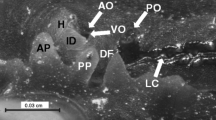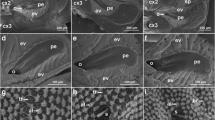Abstract
Relatively little is known about intraspecific variation in the use of chemical defenses by cosmetid harvestmen. In this study, we investigated sexual and ontogenetic variation in the emission of secretions from the scent glands and the morphology of the ozopores of Erginulus clavotibialis, a Neotropical species from Belize. Most individuals (> 94%) did not secrete when seized by leg IV, however, when the body was subsequently grasped firmly with forceps, 76% of the harvestmen (n = 96) responded by releasing enteric fluid (clear, no odor) or secretions from the scent glands (reddish-brown, distinct odor), most commonly in the form of globules near the ozopores. Adults and penultimate nymphs rarely (less than 5% of all trials) exhibited leg dabbing, an unusual behavior generally associated with cosmetid harvestmen. Males released enteric fluid (without scent gland secretions) significantly more than females or nymphs. Nymphs emitted secretions from scent glands at a significantly greater frequency than males or females. Using SEM, we examined the ozopores and the dorsal processes of coxae I and II and found that the morphology of these structures varies between adults and nymphs but not between males and females. The openings of the ozopores of nymphs are circular and are not obscured by the dorsal posterior process of coxa I and the dorsal anterior process of coxa II. In contrast, adults have subtriangular ozopores that are difficult to observe without dissection because they are partially blocked by the dorsal processes of coxae I and II.


Similar content being viewed by others
References
Acosta LE, Poretti TI, Mascarelli PE (1993) The defensive secretions of Pachyloidellus goliath (Opiliones, Laniatores, Gonyleptidae). Bonn Zool Beitr 44:19–31
Bowers MD (2003) Hostplant suitability and defensive chemistry of the Catalpa Sphinx Ceratomia catalpa. J Chem Ecol 29:2359–2367
Caetano DS, Machado G (2013) The ecological tale of Gonyleptidae (Arachnida, Opiliones) evolution: phylogeny of a neotropical lineage of armoured harvestmen using ecological, behavioural and chemical characters. Cladistics 29:589–609
Camarano S, González A, Rossini C (2006) Chemical defense of the ladybird beetle Epilachna paenulata. Chemoecology 16:179–184
Carlson BE, Rowe MP (2009) Temperature and desiccation effects on the antipredator behavior of Centruroides vittatus (Scorpoines: Buthidae). J Arachnol 37:321–330
Carlson BE, McGinley S, Rowe MP (2014) Meek males and fighting females: sexually-dimorphic antipredator behavior and locomotor performance is explained by morphology in bark scorpions (Centruroides vittatus). PLoS One 9. https://doi.org/10.1371/journal.pone.0097648
Chelini M-C, Willemart RH, Hebets EA (2009) Costs and benefits of freezing behaviour in the harvestman Eumesosoma roeweri (Arachnida, Opiliones). Behav Proc 82:153–159
Clawson RC (1988) Morphology of defense glands of the opilionids (daddy longlegs) Leiobunum vittatum and L. flavum (Arachnida: Opiliones: Palpatores: Phalangiidae). J Morphol 198:363–381
Cokendolpher JC (1987) Observations on the defensive behaviors of a Neotropical Gonyleptidae (Arachnida, Opiliones). Revue Arachnologique 7:59–63
Cokendolpher JC, Mitov PG (2007) Natural enemies. Harvestmen: the biology of Opiliones. Harvard University Press, Cambridge, pp 339–373
Cook DR, Smith AT, Proud DN, Víquez C, Townsend VR Jr (2013) Defensive responses of Neotropical harvestmen to generalist invertebrate predators. Carib J Sci 47:333–343
Dossey AT, Walse SS, Edison AS (2008) Developmental and geographical variation in the chemical defense of the walkingstick insect Anisomorpha buprestoides. J Chem Ecol 34:584–590
Duffield RM, Olubajo O, Wheeler JW, Shear WA (1981) Alkylphenols in the defensive secretion of the Nearctic opilionid, Stygnomma spinifera. J Chem Ecol 7:445–452
Edgar AL (1971) Studies on the biology and ecology of Michigan Phalangida (Opiliones). Misc Pub Mus Zool Univ Michigan 144:1–64
Eggenberger F, Rowell-Rahier M (1993) Physiological sources of variation in chemical defense of Oreina gloriosa (Coleoptera: Chrysomelidae). J Chem Ecol 19:395–410
Eisner T, Kluge F, Carrel JE, Meinwald J (1971) Defense of Phalangid: liquid repellent administered by leg dabbing. Science 173:650–652
Eisner T, Jones TH, Hicks K, Silberglied RE, Meinwald J (1977) Quinones and phenols in the defensive secretions of Neotropical opilionids. J Chem Ecol 3:321–329
Eisner T, Rossini C, González A, Eisner M (2004) Chemical defense of an opilionid (Acanthopachylus aculeatus). J Exp Biol 207:1313–1321
Frankfater C, Tellez MR, Slattery M (2009) The scent of alarm: Onotogenetic and genetic variation in the osmeterial gland chemistry of Papilio glaucus (Papilionidae) caterpillars. Chemoecology 19:81–96
García AF, Kury AB (2017) Taxonomic revision of the Andean harvestman genus Rhaucus Simon, 1879 (Arachnida, Opiliones, Cosmetidae). Zootaxa 4338:401–440
Gnaspini P, Cavalheiro AJ (1998) Chemical and behavioral defenses of a Neotropical cavernicolous harvestman: Goniosoma spelaeum (Opiliones Laniatores, Gonyleptidae). J Arachnol 26:81–90
Gnaspini P, Hara MR (2007) Defense Mechanisms. Harvestmen: The Biology of Opiliones, Cambridge, Harvard University Press, pp 374–399
Gnaspini P, Rodrigues GCS (2011) Comparative study of the morphology of the gland opening area among Grassatores harvestmen (Arachnida, Opiliones, Laniatores). J Zool Syst Evol Res 49:273–284
Goodnight ML, Goodnight CJ (1976) Observation on the systematics, development, and habits of Erginulus clavotibialis (Opiliones: Cosmetidae). Trans Amer Micros Soc 95:654–664
Guffey CA (1998) Leg autotomy and its potential fitness costs for two species of harvestmen (Arachnida, Opiliones). J Arachnol 26:296–302
Guffey CA (1999) Costs associated with leg autotomy in the harvestmen Leiobunum nigripes and Leiobunum vittatum (Arachnida, Opiliones). Can J Zool 77:824–830
Hara MR, Gnaspini P (2003) Comparative study of the defensive behavior and morphology of the gland opening area among harvestmen (Arachnida, Opiliones, Gonyleptidae) under a phylogenetic perspective. Arthropod Struct Dev 32:257–275
Hara MR, Cavalheiro AJ, Gnaspini P, Santos DYAC (2005) A comparative analysis of the chemical nature of defensive secretions of Gonyleptidae (Arachnida: Opiliones: Laniatores). Biochem Syst Ecol 33:1210–1225
Harvey BD, Vanni KN, Shier DM, Grether GF (2017) Experimental test of the mechanism underlying sexual segregation at communal roosts of harvestmen (Prionostemma sp.). Ethol 123:516–525
Higginson AD, Delf J, Ruxton GD, Speed MP (2011) Growth and reproductive costs of larval defence in the aposematic lepidopteran Pieris brassicae. J Anim Ecol 80:384–392
Jones TH, Meinwald J, Hicks K, Einser T (1977) Characterization and synthesis of volatile compounds from the defensive secretions of some “daddy longlegs” (Arachnida: Opiliones: Leiobunum spp.). Proc Natl Acad Sci U S A 74:419–422
Jones CG, Hess TA, Whitman DW, Silk PJ, Blum MS (1986) Idiosyncratic variation in chemical defenses among individual generalist grasshoppers. J Chem Ecol 12:749–761
Jones TH, Shear WA, Giribet G (2009) The chemical defenses of a stylocellid (Arachnida, Opiliones, Stylocellidae) from Sulawesi with comparisons to other Cyphophthalmi. J Arachnol 37:147–150
Juberthie C (1976) Chemical defence in soil Opiliones. Rev Écol Biol Sol 13:155–160
Machado G, Pomini AM (2008) Chemical and behavioral defenses of the Neotropical harvestman Camarana flavipalpi (Arachnida: Opiliones). Biochem Syst Ecol 36:369–376
Machado G, Raimundo RLG, Oliveira PS (2000) Daily activity schedule, gregariousness, and defensive behavior in the Neotropical harvestmen Goniosoma longipes (Opiliones: Gonyleptidae). J Nat Hist 34:587–596
Machado G, Bonato V, Oliveira PS (2002) Alarm communication: a new function for the scent-gland secretion in harvestmen (Arachnida: Opiliones). Naturwissenschaften 89:57–360
Machado G, Carrera PC, Pomini AM, Marsaioli AJ (2005) Chemical defense in harvestmen (Arachnida: Opiliones): do benzoquinones deter invertebrate and vertebrate predators? J Chem Ecol 31:2519–2539
Minch EW (1978) Daily activity patterns in the tarantula Aphonopelma chalcodes Chamberlin. Bull Br Arachnol Soc 4:231–237
Moore MK, Townsend VR Jr (2019) Sexual variation in jet emissions from scent glands by Neotropical harvestmen (Opiliones, Cranaidae) from Trinidad. Arachnol 18:17–21
Nazareth TM, Machado G (2015) Egg production constrains chemical defenses in a Neotropical arachnid. PLoS One:1–14. https://doi.org/10.1371/journal.pone.0134908
Nime MF, Casanoves F, Mattoni CI (2016) Microhabitat use and behavior differ across sex-age classes in the scorpion Brachistosternus ferrugineus (Scorpiones: Bothriuridae). J Arachnol 44:235–244
Osses F, Nazareth TM, Machado G (2008) Activity pattern of the Neotropical harvestman Neosadocus maximus (Opiliones, Gonyleptidae): sexual and temporal variations. J Arachnol 36:518–526
Pasteels JM, Grégorie J-C, Rowell-Rahier M (1983) The chemical ecology of defense in arthropods. Annu Rev Entomol 28:263–289
Pomini AM, Machado G, Pinto-da-Rocha R, Macías-Ordóñez R, Marsaioli AJ (2010) Lines of defense in the harvestman Hoplobunus mexicanus (Arachnida: Opiliones): Aposematism, stridulation, thanatosis, and irritant chemicals. Biochem Syst Ecol 38:300–308
Roitberg BD (1992) Insect chemical ecology: an evolutionary approach. Chapman & Hall, New York
Schaider MG, Raspotnig G (2009) Unusual organization of scent glands in Trogulus tricarinatus (Opiliones, Trogulidae): evidence for a non-defensive role. J Arachnol 37:78–83. https://doi.org/10.1636/SH08-01.1
Schaider MG, Komposch C, Stabentheiner E, Raspotnig G (2011) Functional anatomy of scent glands in Paranemastoma quadripunctatum (Opiliones, Dyspnoi, Nemastomatidae). J Morphol 272:1182–1191
Schaus MH, Townsend VR Jr, Illinik JJ (2013) Food choice of the Neotropical harvestman Erginulus clavotibialis (Opiliones: Laniatores: Cosmetidae). J Arachnol 41:219–221
Segovia JMG, Hara MR, Pagoti G, Sannomiya M (2015) The scent glands of the Neotropical harvestman Discocyrtus pectnifemur: morphology, behavior and chemistry. J Chem Ecol 41:716–723
Segovia JMG, Murayama GP, Willemart RH (2018) Sexual differences in weaponry and defensive behavior in a Neotropical harvestman. Curr Zool 2018:1–6. https://doi.org/10.1093/cz/zoy073
Shear WA, Jones TH, Guidry HM, Derkarabetian S, Richart CH, Minor M, Lewis JT (2014) Chemical defense in opilionid infraorder Insidiatores: divergence in chemical defense between Triaenonychidae and Travunioidea and within travunioid harvestmen from eastern and western North America. J Arachnol 42:248–256
Souza EDS, Willemart RH (2011) Harvest-ironman: heavy armature, and not its defensive secretions, protects a harvestman against a spider. Anim Behav 81:127–133
Townsend VR Jr, Víquez C, VanZandt PA, Proud DN (2010) Key to the species of Cosmetidae (Arachnida, Opiliones) of Central America, with notes on penis morphology and sexual dimorphisms. Zootaxa 2414:1–26
Townsend VR Jr, Classen L, Maloney TJ, Moore MK (2019) Stridulation by a cosmetid harvestman. J Arachnol 47:132–141
Weller SJ, Jacobson NL, Conner WE (1999) The evolution of chemical defences and mating systems in tiger moths (Lepidoptera: Arctiidae). Biol J Linn Soc 68:557–578
Whitman DW, Jones CG, Blum MS (1992) Defensive secretion production in lubber grasshoppers (Orthoptera: Romaleidae): influence of age, sex, diet and discharge frequency. Ann Entomol Soc Am 85:96–102
Author information
Authors and Affiliations
Corresponding author
Additional information
Publisher’s Note
Springer Nature remains neutral with regard to jurisdictional claims in published maps and institutional affiliations.
Rights and permissions
About this article
Cite this article
Albert, A.C., Townsend, V.R., Metro, M.C. et al. Intraspecific Variation in the Secretion and Morphology of the Scent Glands of a Neotropical Harvestman (Opiliones, Cosmetidae). J Insect Behav 32, 225–235 (2019). https://doi.org/10.1007/s10905-019-09726-9
Received:
Revised:
Accepted:
Published:
Issue Date:
DOI: https://doi.org/10.1007/s10905-019-09726-9




